
Into the Woods
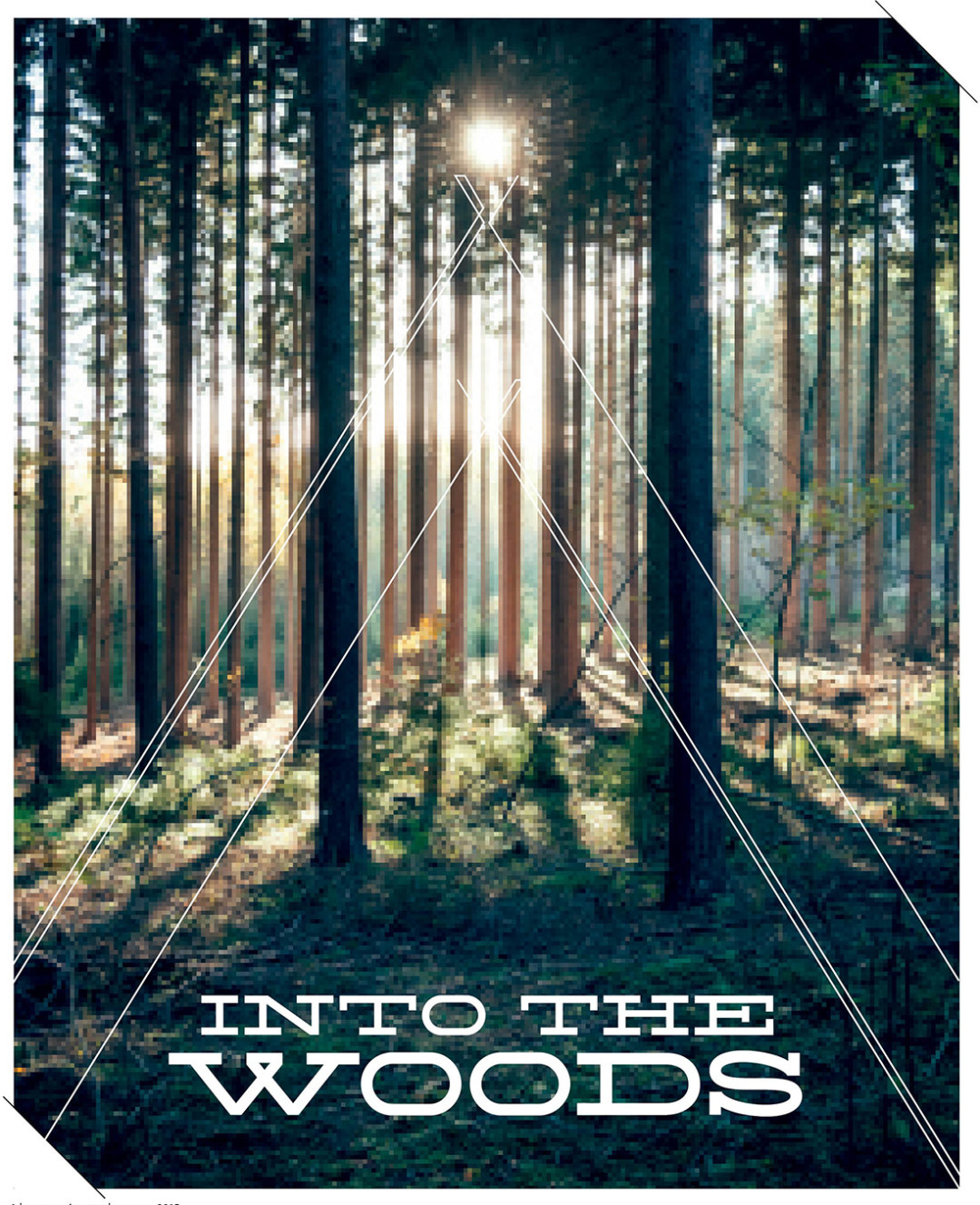
Huts For Vets combines walks in nature, moderated discussions of literature, and soldier-to-soldier bonding to heal the psychological wounds of war.
Like many young American men, Adam McCabe enlisted in the Marines right after 9/11 in a surge of patriotism. Just seventeen at the time, living in Illinois, he had to wait until his eighteenth birthday to deploy. On the front lines of urban warfare in Iraq, McCabe earned two commendations for his bravery and a Purple Heart. On Christmas Day, 2004, his convoy was car-bombed as it returned from Najaf to Karbala.
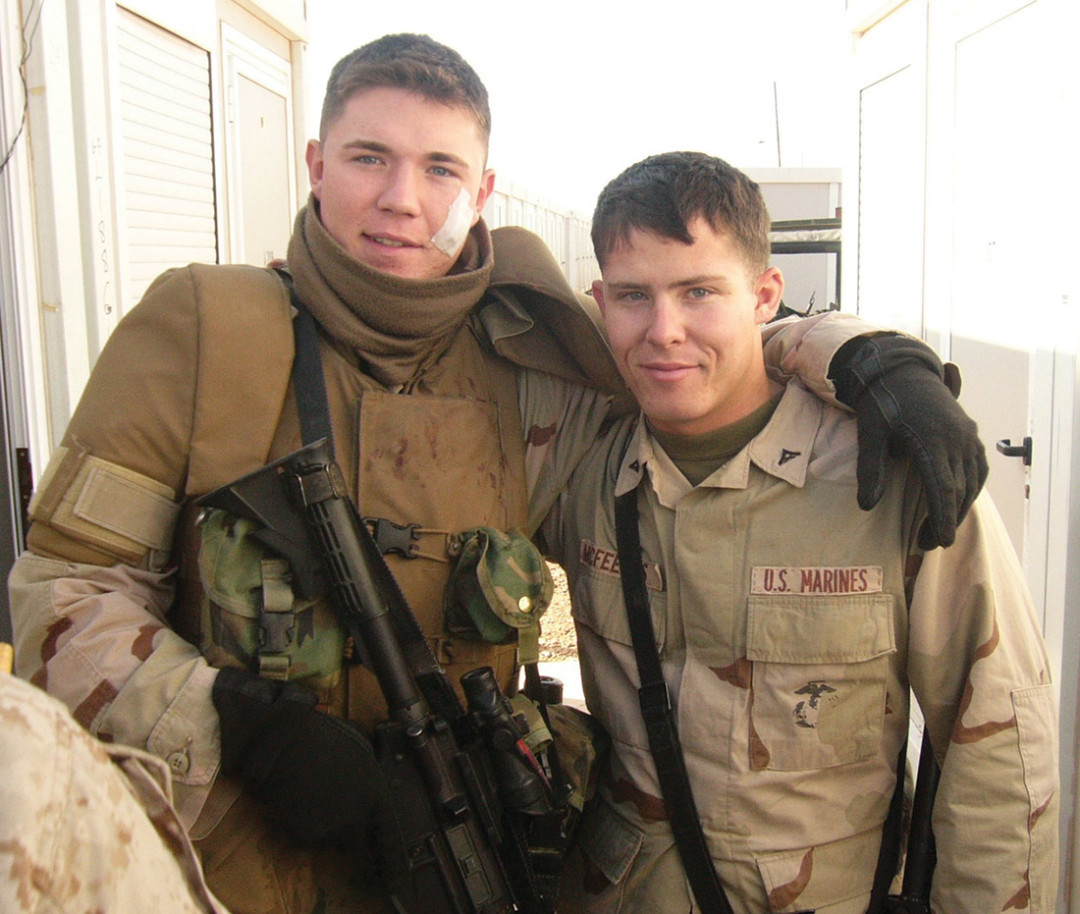
Adam McCabe, left, with a fellow soldier in Iraq
Image: Courtesy: Adam McCabe
Miraculously, he survived. McCabe recalls his horrific experience: “We were sent to pick up a chaplain in Najaf and bring him back to deliver the Christmas Day sermon—we even had a twelve-foot cross with us—when we passed a string of abandoned cars on the side of the road. Iraq had no gas, so it was not unusual to see deserted cars everywhere. The lead vehicle called back that there was a possible car bomb ahead. As the leader, I was in the third of our four-car convoy. We drove by, and the bomber looked me right in the eye. I knew instantly what was going to happen. The next thing I remember was being engulfed in a sea of red.”
McCabe was blown out of the car, suffering facial burns, multiple lacerations, and damage to his eardrums. But when he came to, he recalls, he began grabbing and choking Iraqis. “The only thing I knew was to attack,” he says. “I’m not proud to say that, but that’s what we do. We are trained to be the most elite fighting force there is. And then when we come home, it doesn’t just turn off.”
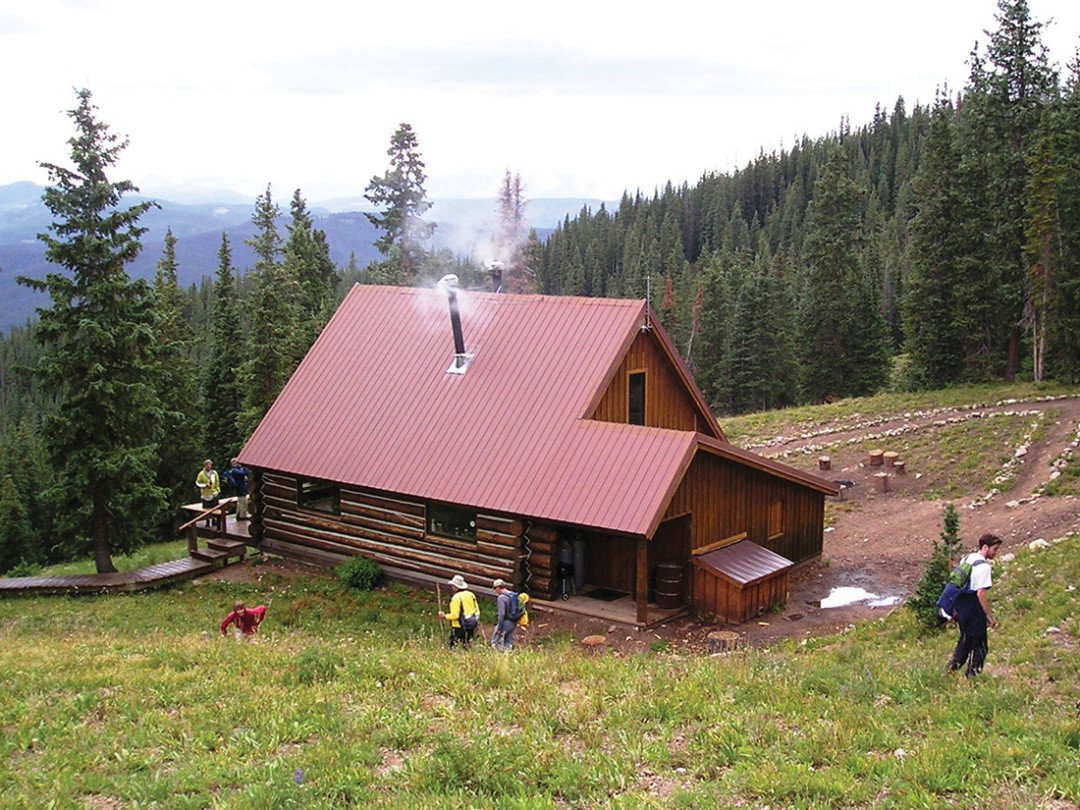
Image: Courtesy: Huts for Vets
When McCabe finally returned home to Illinois after two deployments, he was a wreck, suffering from post-traumatic stress disorder. “I wasn’t prepared for my homecoming,” he recalls. “I couldn’t look at myself in a mirror. Combat is ugly, and it brings out ugly things in people. I was angry and aggressive and drinking too much.”
Reaching out for help, he eventually found programs and people who helped him recover. “I had to learn new tools to help me integrate into the community and put aside the tools that had helped me survive in combat,” he says. In 2007, McCabe moved from Illinois to Carbondale and found a very supportive community. He has dedicated his life’s work to helping other veterans recover and develop the skills to combat PTSD.
McCabe’s war experience mirrors that of many of the soldiers participating in the Huts For Vets program (hutsforvets.org), where he serves as chief of operations. Huts For Vets is the brainchild of Paul Andersen, who in January 2013 founded the nonprofit to provide wilderness and communal experiences as therapeutic healing for military veterans, using the 10th Mountain Division Hut System as a base of operations.
“So many vets have developed ‘soul wounds’ from seeing and doing things that violate man’s deepest moral precepts,” Andersen says. “Our goal is to fully engage participants at psychological and experiential levels through immersion in wilderness, physical challenge, philosophical exploration, and contemplative thought.” That translates to three days of wilderness hiking and communal living at one of the 10th Mountain Division huts in a relaxed and non-clinical environment. Besides their formal and informal group discussions centered on selected readings, veterans go on wilderness solos. They also do service projects to maintain the hut system.
A familiar face to many in Aspen, Andersen is an experienced journalist, environmentalist, historian, screenwriter, and author of scores of newspaper and magazine articles, plus twelve books, but he is not a military veteran. So why Huts For Vets? “I was drawn to the grim statistic that twenty-three veterans lose their lives to suicide every day. That is one suicide every sixty-five minutes,” Andersen says. He goes on to note that approximately 0.5 percent of the American population serves in the military and only 15 percent of those are on the front lines of battle. “They are a forgotten group. I realized that there was no way I was going to stop war or see it end in my lifetime, and so the best I could do is help veterans.”
The model for Huts For Vets grew out of Andersen’s experience as the originator and co-moderator of the Wilderness Seminars for the Aspen Institute’s Nature and Society program from 2005 to 2008. In those seminars over five days, participants explored the philosophical relationships between man and nature through readings and immersion in the wilderness surrounding Aspen. When the program ended, Andersen began investigating other demographic groups that could benefit from a wilderness program and found himself reading more and more about veterans and the harsh realities of PTSD, substance abuse, depression, domestic violence, and life challenges that many suffer upon returning home.
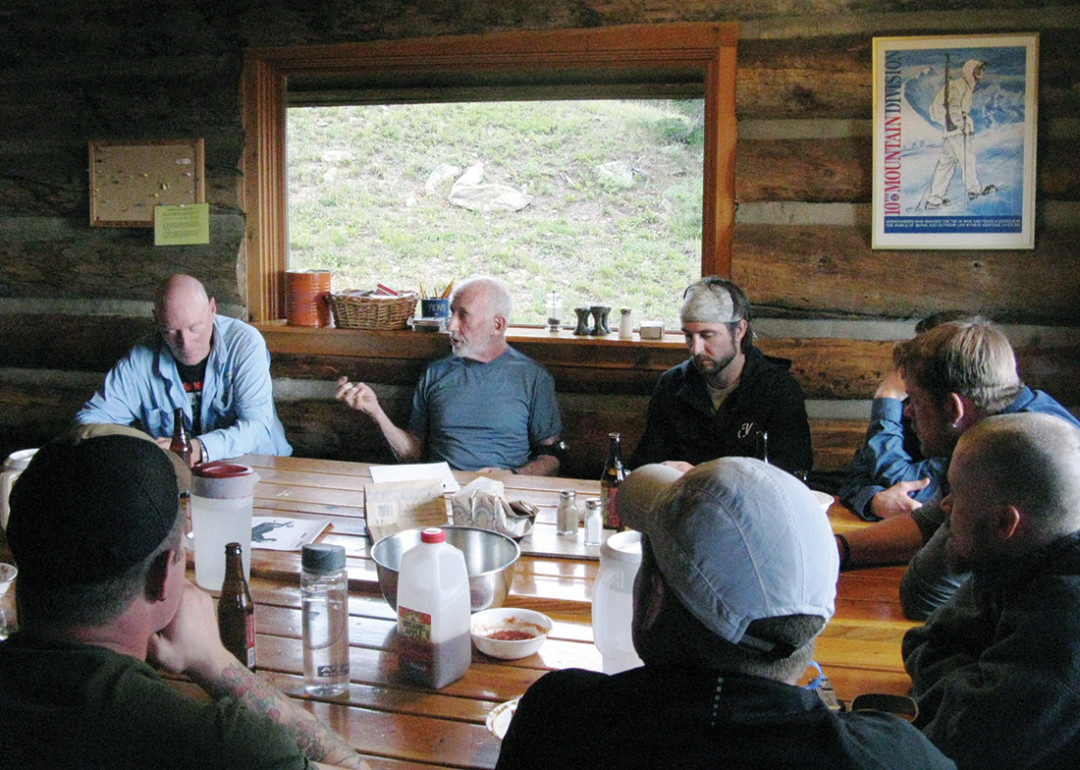
Psychologist Gerald Alpern, center, leads a discussion at Margy’s Hut.
Image: Courtesy: Huts for Vets
“I discovered that many veterans were surviving on a plethora of pills that just treated the symptoms, not the causes of their suffering,” he says. “One vet told me, ‘War is a place of no beauty.’ For me, wilderness is nothing but beauty, and I started thinking that, perhaps, it could be an antidote to the psychological effects of war.”
Andersen also uncovered studies revealing the disturbing impact of multiple deployments upon today’s soldiers. “For many soldiers, it’s a yo-yo experience in and out of the military that eventually accrues into confusion,” he says. “When they come home, they can’t adjust. There are no qualified listeners who can understand what they have gone through. The first-year dropout rate from college is 88 percent for returning vets, because they can’t relate to eighteen-year-old freshmen. Only 6 percent graduate with a college degree. Many return to battle. Others commit suicide.”
Andersen’s goal is to create a sense of normalcy for the vets who go through his program. “Just being together and talking about shared experience helps,” he says. The success of the program is reflected in the many unsolicited entries written by veterans in the Hut Log Book. Justin Jackson (Army, Afghanistan), for example, writes, “Words cannot express the impact this experience has had on my heart and soul! Wilderness therapy for combat vets is an incredible and innovative concept. What a journey! I have come further in the last three days than I have in two years dealing with the VA. I pray that my fellow brothers and sisters in arms find their way to experience the enlightenment that Huts For Vets has provided. God bless!”
But we in it shall be remembered—
We few, we happy few,
we band of brothers;
For he to-day that sheds his blood with me
Shall be my brother…
— William Shakespeare, Henry V,
one of many readings Huts For Vets uses to
prompt conversation in moderated discussions
Still in its infancy, Huts For Vets sponsors four programs a year, funded by individual donors and public and private grants, including most recently a grant from the John Denver Aspenglow Fund. Andersen and McCabe actively recruit vets for the program through veterans’ groups and IAVA (Iraq Afghanistan Veterans of America). Most Huts participants are in their 30s and 40s and have reached a wall in their recovery.
“We look for the most at-risk population, vets who have seen combat,” Andersen says. “Many of them are Marines.” In 2014, Huts ran its first program for women. “On the first hike, one of the women severely injured her ankle,” Andersen recounts. “We had to wait for the paramedics to arrive, and then the women carried her out of the woods on a stretcher to a waiting helicopter. One vet said, ‘It was like being back in country.’”
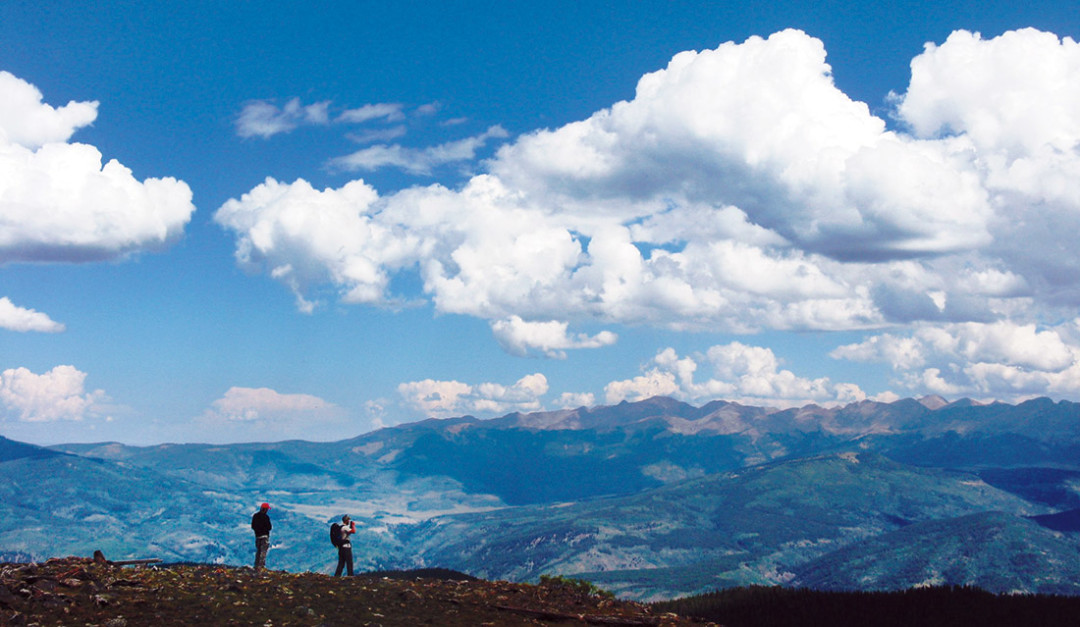
Vets taking in the expanse of the Hunter-Frying Pan Wilderness.
Image: Courtesy: Huts for Vets
Each program includes ten vets and takes place over three and a half days. All expenses are paid for each participant through private funding raised by Andersen, because, he says, “they’ve already paid.” Colorado Mountain Express transports them gratis from Denver to Aspen. On their arrival, the vets go to the Green Cabin Estate in Snowmass, a mansion donated by the Aspen Skiing Company, for dinner and orientation. Over the next three days, they stay at Margy’s Hut, one of thirty-four backcountry huts in the 10th Mountain Division Hut System, which was started in the early 1980s and named after the distinguished World War II mountaineering division. In a bit of historical symmetry, Robert McNamara, secretary of defense under Presidents Kennedy and Johnson and architect of the Vietnam War, funded the construction of Margy’s Hut (named for his wife) and his own eponymous hut.
“Margy’s Hut is located at the portal of the Hunter-Frying Pan Wilderness,” Andersen says. “There’s not a lot of traffic. When you enter the trailhead, you are entering a different world.” Preston Williams (Army, Kuwait) concurs: “Not only have I been allowed to see some of God’s most beautiful landscapes throughout the Hunter-Frying Pan Wilderness Area, but I have also been able to connect with fellow vets with similar situations and reflect on where I am now and where I want to be.”
With no cell phones, televisions, or outside distractions, the vets are away from their daily lives and in a protected space where they can begin to share their stories with each other. One of their destinations is Mt. Yeckel. More than one vet who has reached the 12,000-foot summit and marveled at the panoramic views of the Elk Mountain Range, Holy Cross, and the Hunter-Frying Pan Wilderness has written, “This is what I fought the war for. This is the America I want to protect!”
I went to the woods because I wished to live deliberately, to front only the essential facts of life, and see if I could not learn what it had to teach, and not, when I came to die, discover that I had not lived. … I wanted to live deep and suck out all the marrow of life.
—Henry David Thoreau, Walden – Or Life in the Woods
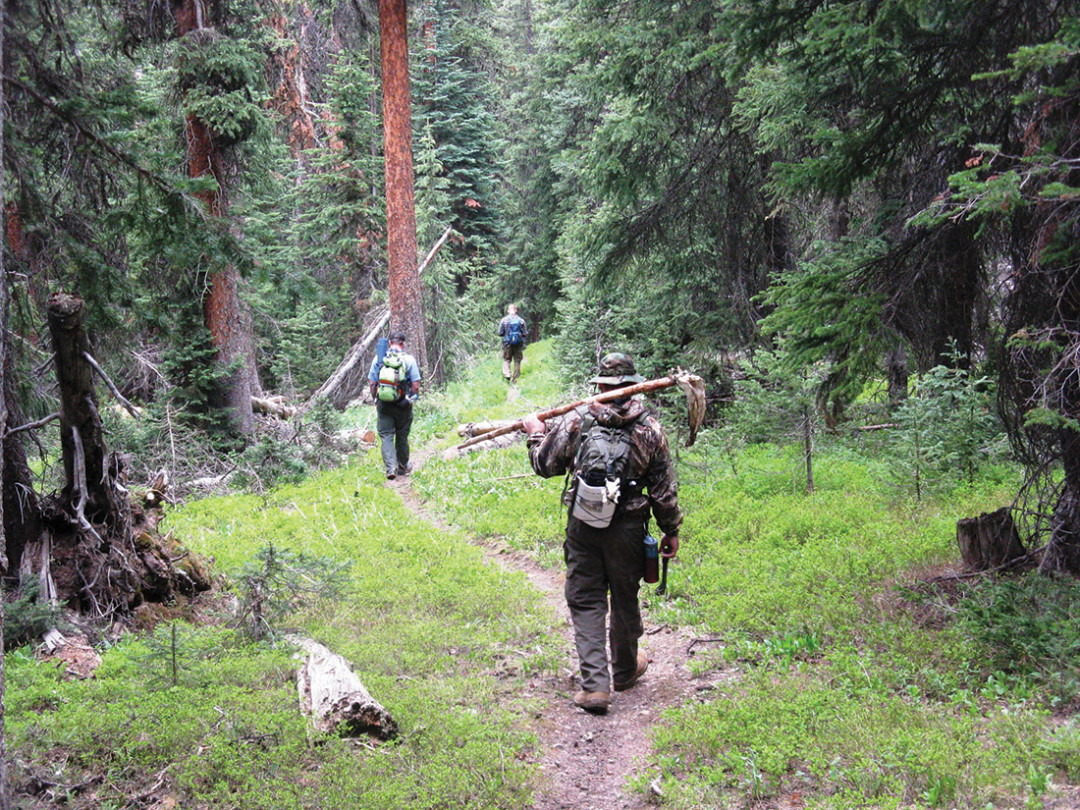
Vets on the trail
Image: Courtesy: Huts for Vets
Besides their daily hikes, moderated discussions, and wilderness solos, the vets also learn mental health tools from Dr. Gerald Alpern, a clinical psychologist, Huts board member, and Korean War veteran. Before PTSD was identified medically in 1980, there were various names for the same symptoms in different wars: shell shock, battle fatigue, irritable heart, hysteria, estar roto (to be broken), and maladie du pays (homesickness). Alpern is familiar with them all. As an Army medic during the Korean War and later a psychiatric aide at Valley Forge Army Hospital, Alpern witnessed firsthand the symptoms and early treatment protocols for PTSD, including insulin shock therapy. “It was the doctor’s duty to get soldiers back on the front lines as soon as possible,” he says. “They prescribed medications that had their own unintended consequences.”
Alpern goes on all of the treks and offers his expertise on mental health issues in group discussions. He teaches Pennebaker writing, a method of writing therapy to ease the emotional impact of traumatic events. “I came to Huts For Vets expecting to be available for wounded souls,” Alpern says. “I didn’t expect to learn how talented, dedicated, and just plain great vets are. Yeah, they suffer problems, but their courage and motivation to continue to give to others has been a revelation.”
One of the tools participants learn in Huts For Vets is TRE (Tension and Trauma Relaxing Exercises), a series of exercises utilizing tremors to release tension from the large muscle groups in the body.
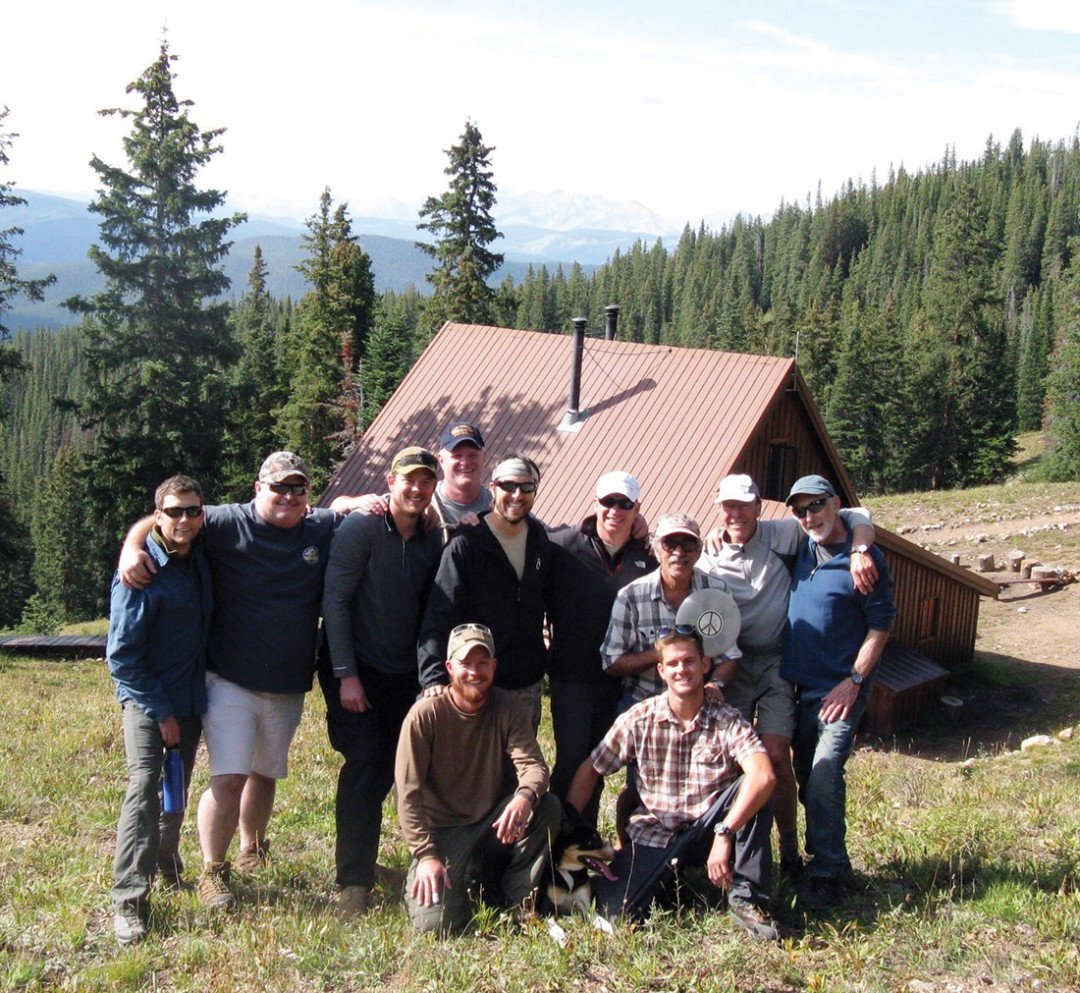
Image: Courtesy: Huts for Vets
David Berceli, a clinical psychologist, originated TRE after studying many people with various forms of trauma. He found that it was particularly effective for returning veterans with PTSD. As a page on his foundation’s website (bercelifoundation.org) explains, “The body stores the memories, thoughts, and emotions of the trauma in order to process them at a later date. The high chemical charge left in the body after trauma continually seeks to discharge. When that discharge does not occur, both the emotional and rational parts of our brains translate this excessive charge into either intense emotions such as hatred, rage, shame, etc., or ideas of revenge, distrust, or negative ideology.”
As the body lets go of stored tension, the brain is able to return to a more normal state of relaxation. Despite empirical evidence of TRE’s effectiveness, Berceli acknowledges that more medical research is “essential to understanding the biochemical, physiological, and psychological responses to these tremors.”
McCabe, who is also Huts For Vets’ TRE instructor, recalls his first experience with TRE: “One of my jobs in Iraq was kicking down doors to rout out the bad guys. The first time I got my legs to tremble through TRE, my right leg involuntarily shot up into the same kicking position. It’s incredible to see how the body stores memory.”
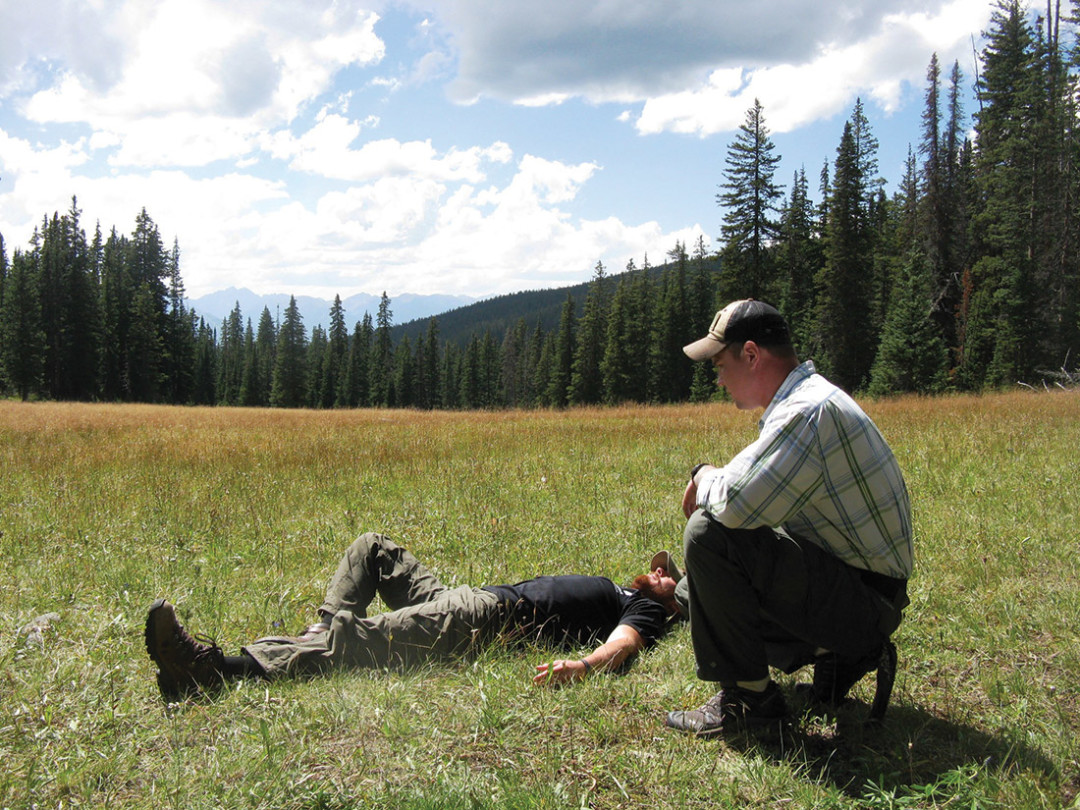
Image: Courtesy: Huts for Vets
Perhaps the most healing moment of the Huts For Vets program is the hike out of the wilderness on the last day. Both McCabe and Andersen talk about the importance of decompression time for returning vets. “The homecoming is more dangerous than combat,” McCabe says. “We gear people up to fight, but we don’t have any plan to help them with their transition from combat to community when they come back.”
Andersen concurs. “Our last hike out of the woods is very therapeutic. The vets are literally walking out of the wilderness and back into their own lives, having gained, we hope, some inner peace and tools to face the future.”














































